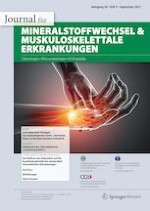11.08.2021 | Originalien
Anti-Sklerostin-Therapie aus nephrologischer Sicht – mit einem Fokus auf kardiovaskuläre Sicherheit
Erschienen in: Journal für Mineralstoffwechsel & Muskuloskelettale Erkrankungen | Ausgabe 3/2021
Einloggen, um Zugang zu erhaltenZusammenfassung
Die Zusammenhänge zwischen Sklerostin und Knochendichte, Gefäßverkalkung, kardiovaskulärer Morbidität und Mortalität bei chronischer Niereninsuffizienz („chronic kidney disease“, CKD) sind komplex und unvollständig verstanden. Es gibt experimentelle Hinweise, dass eine Anti-Sklerostin-Therapie bei CKD eine verminderte Wirkung auf den Knochen hat. Da Sklerostin auch sehr prominent in urämischen Gefäßen exprimiert wird, sind die möglichen kardiovaskulären Folgen einer Sklerostin-Hemmung bei CKD unklar. Der vorliegende Review gibt einen Überblick über die Physiologie und Pathophysiologie von Sklerostin in Knochen und Gefäßen bei CKD, den aktuellen Kenntnisstand zur Wirksamkeit und kardiovaskulären Sicherheit der Hemmung von Sklerostin bei Nierengesunden und CKD sowie die daraus resultierenden therapeutischen Implikationen.
Anzeige
